If you happen to purchase an merchandise through hyperlinks on this web page, we might earn a fee. Our editorial content material isn’t influenced by commissions. Learn the total disclosure.
Citrus bushes might be absolute treasures to develop at house. Along with their scrumptious fruits, their blossoms and leaves are sublimely aromatic, and lots of citrus components have medicinal and cleaning properties.
However what in the event you don’t dwell in USDA Zones 8-11 and might’t develop lemons, limes, or oranges open air? If you happen to’re feeling adventurous, you’ll be able to strive rising citrus bushes indoors as a substitute.
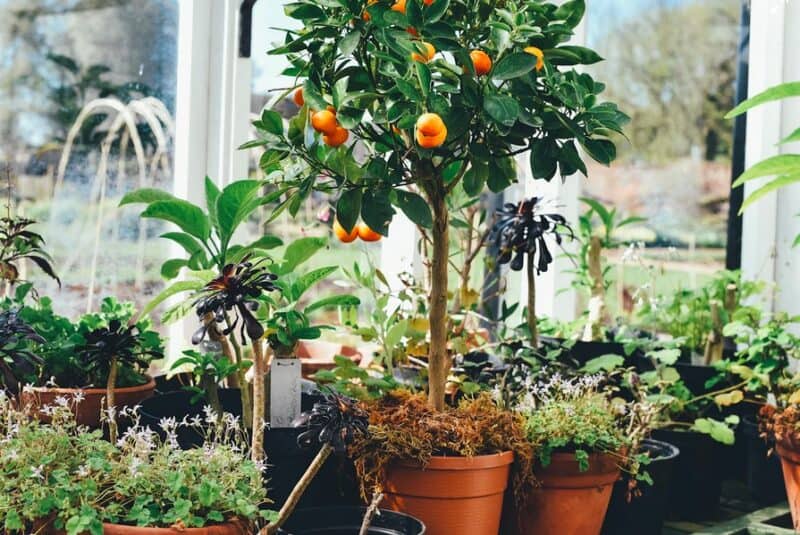

The easy reply right here is “sure.” Individuals have cultivated citrus bushes indoors of their properties or greenhouses for hundreds of years. The truth is, the traditional Romans grew citrus bushes in proto-greenhouses often called “solaria.”
They used thinly sliced selenite gypsum in lieu of glass for his or her solaria, the place they grew melons, citrus, and different summer time fruits year-round.
Like most different fruit bushes, rising citrus bushes indoors works effectively, offered they get sufficient mild and persistently heat temperatures. The bottom line is to get an acceptable species that’ll thrive in your house surroundings after which nurture it lovingly because it matures.
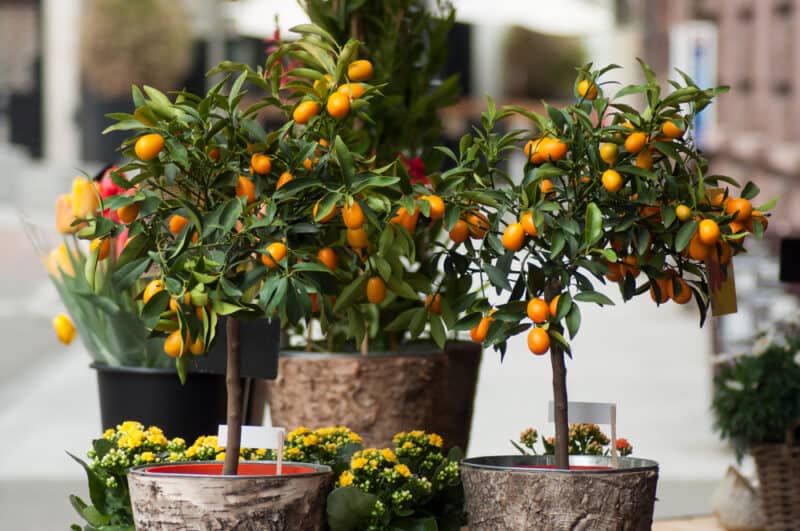

One of many major causes citrus bushes thrive in areas nearer to the equator is the sheer quantity of warmth and sunshine they get day by day.
To develop citrus bushes indoors, you want a superb 8-12 hours of daylight day by day, and constant temperatures that don’t drop beneath 65-70°F (18-22°C) with few exceptions.
As such, you’ll have to develop your bushes close to the sunniest window you might have and/or present develop lights for supplemental UV publicity.
A south-facing window is good as a result of it’ll grant your bushes probably the most mild and heat doable. That mentioned, in the event you’re in a chilly local weather, you’ll want to make sure that no drafts are coming in by way of the window.
Citrus bushes indoors and out are very delicate to temperature fluctuations, so in the event you’re in Zones 3-6 and also you don’t have double-glazed home windows, take into account sealing them with plastic over the winter so your bushes don’t catch chilly.
Through the summer time months, you’ll be able to take into account transferring your citrus bushes exterior to allow them to get full publicity to sunshine, rain, and native pollinators. Simply notice that you simply’re additionally exposing them to potential pathogens and bug infestations by doing so. Extra on that later.
These bushes are additionally delicate to humidity ranges and don’t fare effectively in terribly dry environments. If you happen to discover that your private home is sort of dry in the course of the winter months (particularly widespread in the event you burn wooden for warmth), then it’s a good suggestion to spend money on a humidifier.
Moreover, use a twig mister in your bushes repeatedly to allow them to soak up moisture by way of their leaves.
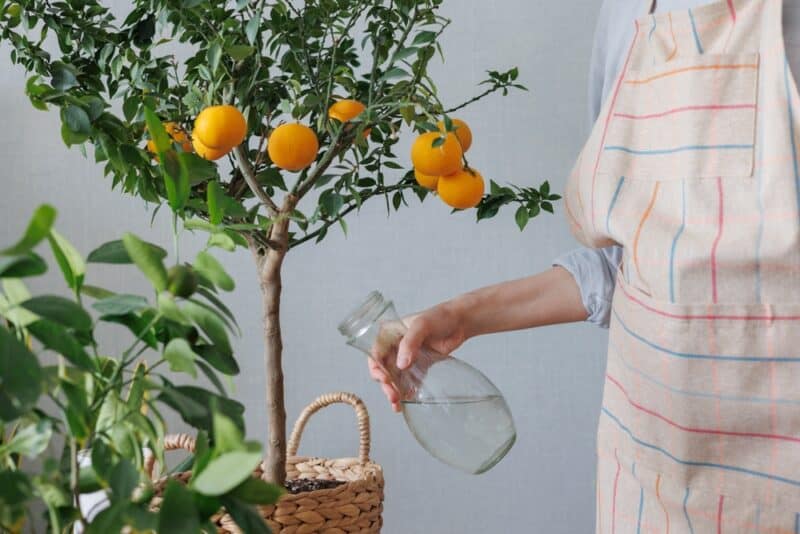

In the case of the soil, you’ll want on your citrus bushes, drainage is your greatest good friend. Severely, it’s good to make drainage a precedence, otherwise you’ll danger root rot and fungus gnats.
Select massive containers on your bushes and fill them with well-draining potting soil. This could include loads of perlite or volanic rock for each aeration and drainage, in addition to coconut coir and/or peat moss to retain moisture.
Citrus bushes favor impartial to barely acidic soil, so search for one within the 6.0 to 7.5 pH degree. Industrial soils that additionally include worm castings or aged compost may help hold your bushes well-nourished as effectively.
One thing like FoxFarm’s Ocean Forest potting combine could be good. Seize some from Amazon in 12-quart baggage.
Intention to fertilize your indoor bushes each 4-6 weeks all through the rising season, in any other case they’ll deplete vitamins from their soil fairly shortly. They do effectively with a balanced N-P-Ok ratio fertilizer or with common doses of selfmade compost tea.
By no means use fertilizer sticks, as they will “burn” the roots.
You’ll find fertilizers made particularly for potted citrus bushes, like Bloom Metropolis’s Natural Citrus & Fruit Fertilizer, obtainable at Amazon.
So far as watering goes, youthful bushes (below the age of 4 or so) have to be watered as soon as every week in the course of the rising season, whereas extra mature bushes can go so long as 10-14 days between waterings.
You don’t wish to water them too typically or else you danger root rot. Ideally, in the event you stick your finger down into the soil to the second knuckle, you need to simply have the ability to really feel moist soil. It shouldn’t be moist sufficient to stay to you while you pull it again out once more.
Think about using a soil moisture meter to maintain issues regulated, as both an excessive amount of or too little water can kill your tree(s).
Your citrus bushes don’t have to be watered as typically in the course of the winter months. They go dormant and gained’t soak up a lot of the water you supply them.
By no means hydrate your citrus bushes with chilly water. This may make them “shiver” and drop their leaves from shock. The water you employ ought to at all times be at room temperature or perhaps a little bit hotter so that you don’t traumatize your bushes.
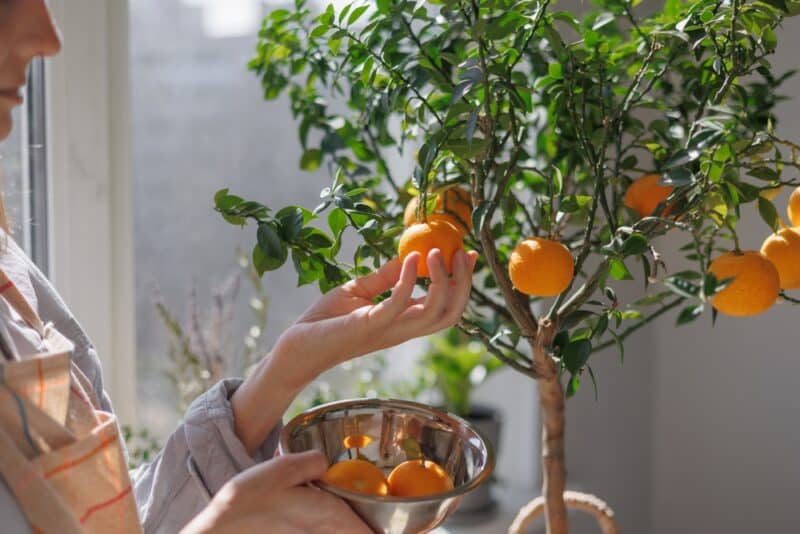

If you happen to don’t need your citrus bushes to develop up by way of your ceiling, you’ll seemingly have to prune them. Kumquats are sufficiently small so that you don’t have to fret about this problem, however for all of the others, you’ll have to trim them again repeatedly.
It’s greatest to prune citrus bushes throughout their early rising season, sometimes in spring or early summer time, or after they’ve fruited. Use sterilized backyard snips to chop again the branches and to trim them in the course of the rising season if issues begin to bush out an excessive amount of.
Moreover, it’s essential to notice that many citrus bushes have spiky thorns on their branches. These develop to guard the bushes from predators and might be lower than pleasant if and while you again into them whereas vacuuming.
They can be fairly harmful when you’ve got young children or rambunctious pets round. It’s a good suggestion to make use of these sterile snips to chop off the thorns so no one will get harm.
As an apart, bear in mind which you could at all times espalier your citrus tree indoors if you wish to save house. This requires you to coach their branches horizontally towards a sunny wall, reasonably than permitting them to bush out. It’s a terrific possibility for smaller areas, offered they get sufficient sunshine every day.
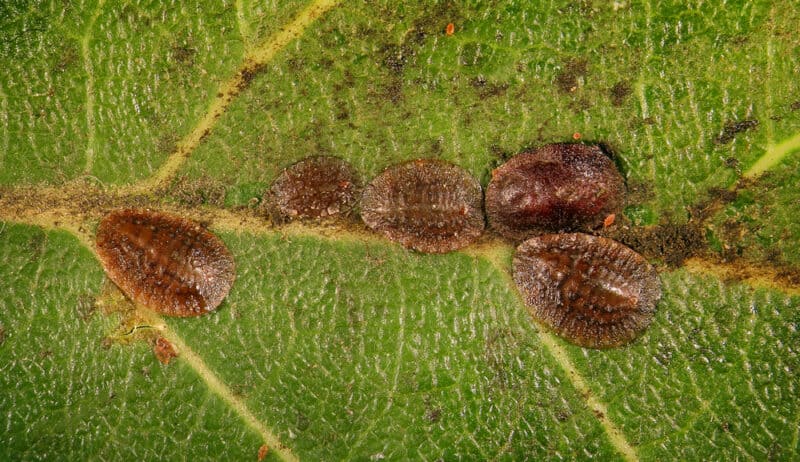

If you happen to’re cultivating these bushes for fruit, it’s essential to notice that though most citrus bushes are self-fertile, lots of them are wind-pollinated within the wild.
As such, it’s possible you’ll have to placed on some candy tunes and pollinate your citrus flowers with a smooth paintbrush to get the pollen from anthers to types.
Moreover, though citrus bushes indoors are much less prone to be affected by the identical well being points that out of doors bushes might undergo, there are a number of issues that they will nonetheless undergo from:
On the off likelihood that your different houseplants get contaminated with spider mites, these can mosey on over to your citrus bushes as effectively.
Earlier on this article, we mentioned how one can transfer your bushes exterior in summertime to allow them to play within the sunshine and rain for some time. This makes them very comfortable but in addition makes them a goal for predators and pathogens.
It’s as much as you whether or not you’d prefer to danger them getting rust, canker, or different ailments from being uncovered to the weather.
Moreover, citrus bushes want adequate nitrogen or they’ll begin dropping their leaves. In case your tree’s leaves are trying yellow or drooping and falling off, give them a dose of high-nitrogen fertilizer. That is particularly essential throughout their foliar section in spring and early summer time earlier than they flower in earnest.
Until your private home has severely tall ceilings, you’ll both wish to look into dwarf cultivars or hold your pruning shears helpful. Commonplace citrus bushes can develop between ten and 22 ft in top, whereas dwarf varieties common between six and 11 ft.
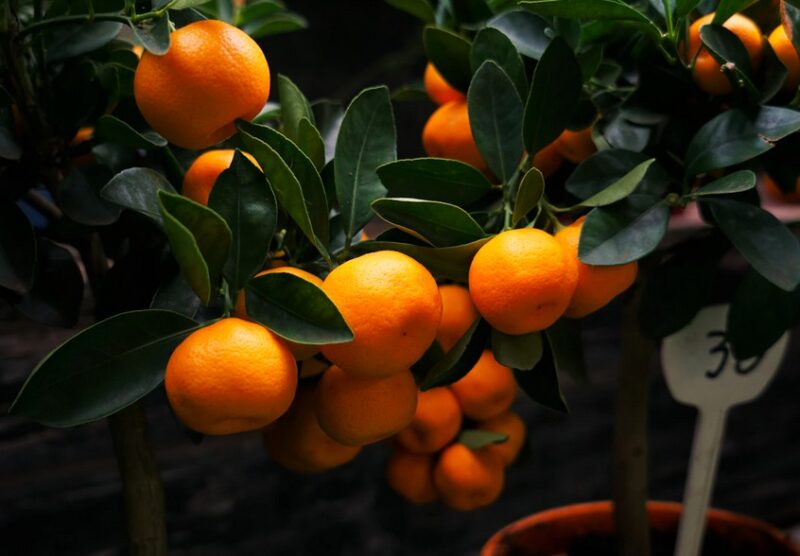

These fairly citrus bushes (Citrus × clementina) produce among the tastiest fruits round, and are unlikely to develop taller than 8 ft when grown in a pot indoors.
Because the common ceiling in North America is 8-10′, you may get away with rising clementines in nearly any room in your home, offered that it will get sufficient daylight. If you happen to discover that it’s getting too tall, with leaves brushing the ceiling, prune it again to round 7 ft.
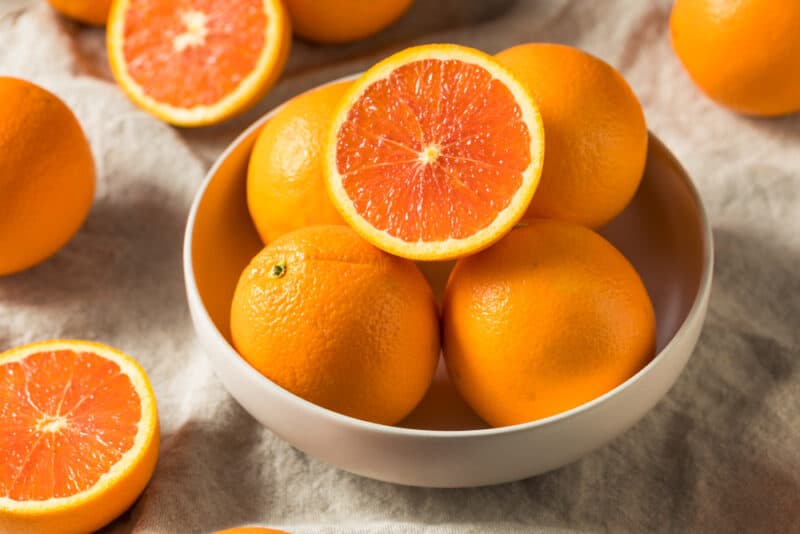

If you happen to love berries as a lot as you like citrus, then take into account rising a cara-cara (C. × sinensis ‘Cara Cara’). These citrus bushes produce fruits that style like a mixture of orange, pink grapefruit, raspberry, and cranberry.
Severely, in the event you haven’t tried them earlier than, see if you may get your palms on a few of these fruits at your native South American grocery retailer. They’re initially from Venezuela however have naturalized in tropical areas.
Not solely are the blossoms from Trovita orange (C. × sinensis ‘Trovita’) bushes scented exquisitely, however in addition they produce among the sweetest orange fruits round.
They’re exceptionally low-maintenance and gained’t develop too massive in the event that they’re planted in smaller containers, round 9 ft at full maturity. Though these citrus bushes want much less warmth than different cultivars, their fruit can be sweeter and juicier if their environment are fairly scorching.
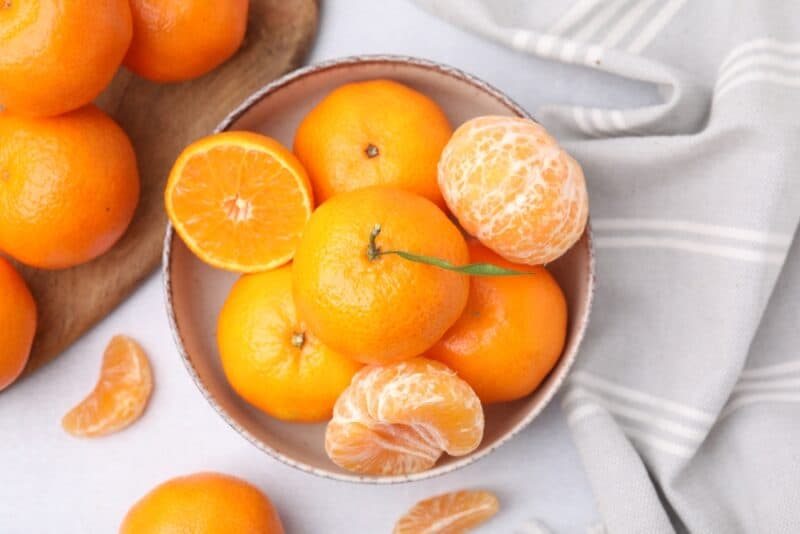

In contrast to the opposite citrus bushes on this checklist, tangerines (C. x tangerina) are solely partially self-fertile. As such, though they may produce fruit in the event you pollinate them from their very own blossoms, you’ll get a extra considerable harvest in the event you develop a minimum of two bushes for cross-pollination.
Dancy tangerines, particularly, are treasured by indoor growers as a result of they solely develop about 9 ft tall in pots and are way more drought-tolerant than different cultivars.
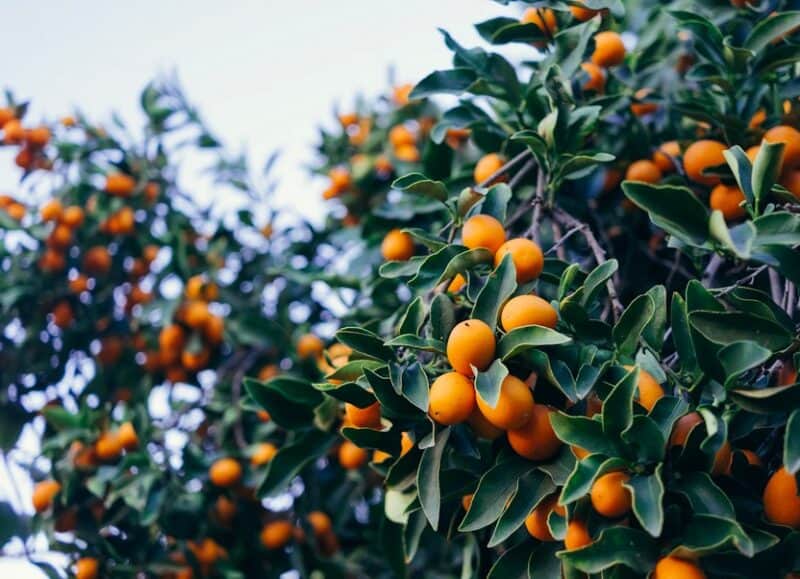

Kumquat citrus bushes (Citrus spp.) are among the loveliest crops you’ll ever see. Severely, they’re ridiculously cute, aromatic, and produce super-tasty fruits as effectively. You can’t go mistaken with having a minimum of certainly one of these at house.
Dwarf varieties solely develop about six ft tall, and produce quail egg-sized fruits which are completely scrumptious. You’ll be able to stunt their progress by maintaining them in smaller containers, and a few individuals even domesticate their kumquats as bonsai bushes!
If you happen to go this route, you’ll be able to plop yours onto any sunny countertop in your house and develop your citrus bushes indoors proper the place you’ll be able to get pleasure from them.
Decide up a three- to five-inch dwell plant at Amazon.
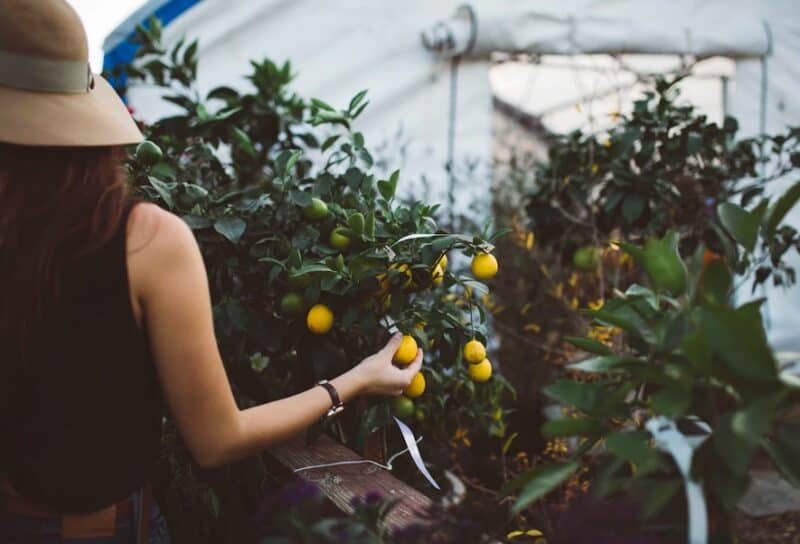

If you happen to guessed that it is a hybrid between a kumquat and a lime, you’d be appropriate. Nicely executed! Limequats (C. × floridana) are normally hybrids between key limes and kumquats, and the fruits have sweet-tart flesh and skinny, edible skins.
I favor to not eat the skins, however they’re fantastic in selfmade marmalade. These bushes are between six and ten ft tall at full maturity, so that they’ll match into most house environments with a little bit of mild pruning.
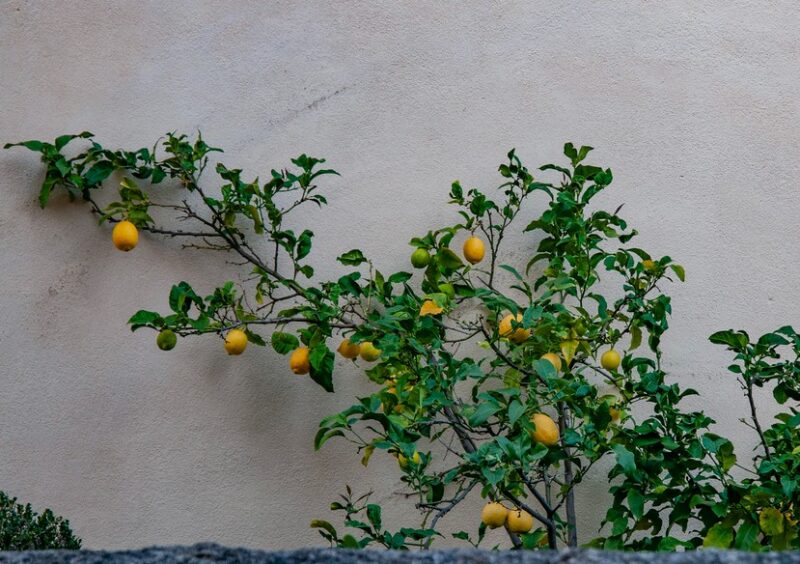

When life provides you lemons… develop extra lemon bushes from them!
No, severely: I’ve two lemon bushes (C. × limon) that I’ve grown from seed (harvested from an natural, store-bought lemon), and I completely love them.
They’re over 12 ft tall now, and though they’re nonetheless too younger to bear fruit, the perfume from the leaves is past beautiful. A typical potted lemon tree will develop 10-15 ft tall at maturity, so except you might have ridiculously excessive ceilings, you’ll must prune yours down.
Right here’s a tip: lengthy earlier than your lemony citrus bushes bear fruit, you should utilize the leaves various alternative ways. Crush them barely in your palms and tuck them between sheets in your linen closet to impart a beautiful scent.
Dry them and crumble them into sachets to deodorize footwear and boots, or infuse vinegar and water with them for an eco-friendly room spray deodorizer.
Wager you didn’t know that rising citrus bushes indoors would allow you to clear your home!
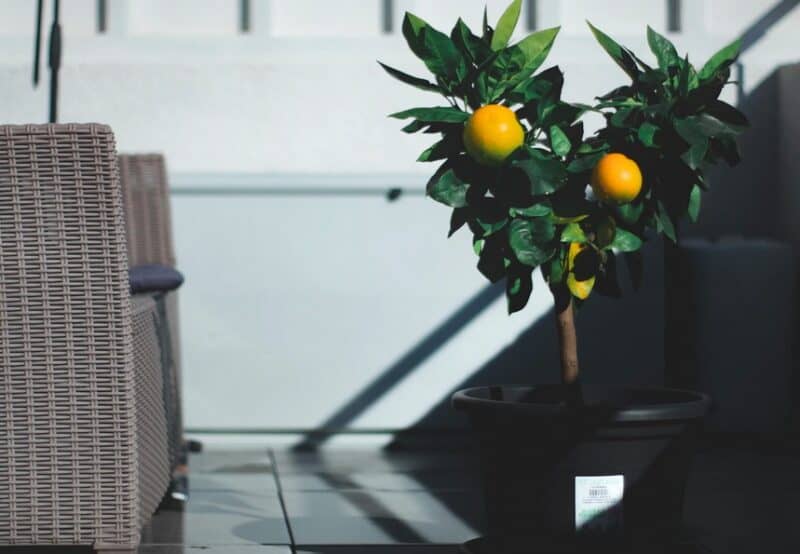

Meyer lemons (C. x meyeri) are a few of my favourite citrus fruits. They’re sweeter and fewer acidic than customary lemons, and their blossoms fill the air round them with an unimaginable perfume.
You should buy dwarf Meyer lemon citrus bushes at nurseries — both native or on-line — or just purchase some natural Meyer fruits and sprout the seeds your self in the event you don’t thoughts ready a number of additional years on your bushes to bear fruit.
If you happen to’re in Florida, seize a dwell Meyer lemon plant in gallon pots at Amazon. Exterior of Florida, yow will discover a six- to- ten-inch dwell plant at Amazon.
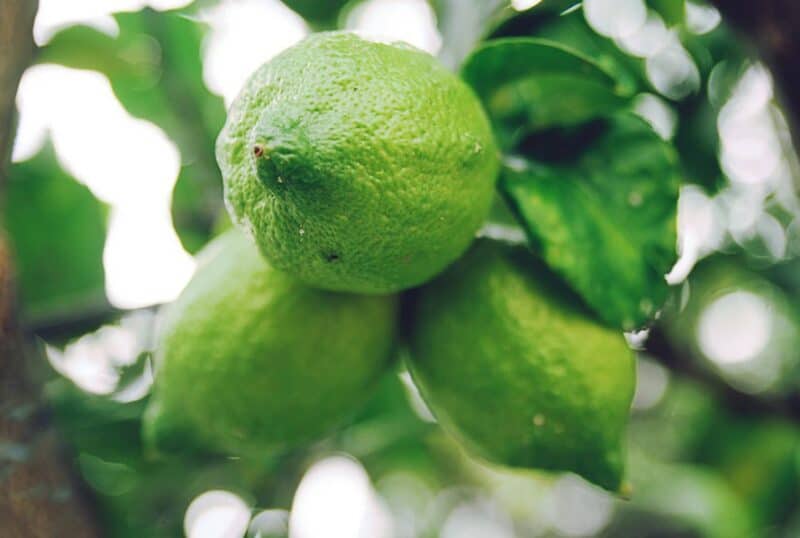

If you happen to actually like the flavour of lime, then you’ll be able to’t go mistaken with a luscious lime tree rising in your kitchen or front room. Their flowers and leaves odor unimaginable, and their fruits are attractive in varied worldwide dishes, in addition to in refreshing drinks and tonics.
A median lime tree will develop as much as ten ft when mature however will seemingly be shorter than when grown indoors in a pot.
Moreover, limes (Citrus spp.) might be invaluable across the homestead for medicinal and cleansing functions. Lime has important antimicrobial properties, and the extract (tincture) and important oil (EO) can be utilized to deal with contaminated wounds.
Moreover, lime EO is superb for disinfecting surfaces like kitchen and toilet counter tops, because it’s an efficient antibacterial and antifungal as effectively.
‘Bearss’ is a superb lime for indoors as a result of it stays small. It’s additionally extraordinarily tolerant of low temperatures, even just under freezing.
Kaffir limes can be good, although you’ll have to prune them repeatedly as they will develop massive. If you happen to’d like a kaffir lime for rising indoors, head to Amazon for a 3 to five-inch tall dwell plant.


Australian finger lime bushes (C. australasica) are perfect for smaller areas, as they solely develop six to eight ft tall at full maturity. Their fruits can develop three to 5 inches lengthy, with granular, pearl-like flesh that tastes (and feels) reasonably like lime-flavored caviar.
These are completely ideally suited citrus bushes to develop indoors, as they’re simply as low upkeep as they’re stunning. And scrumptious.
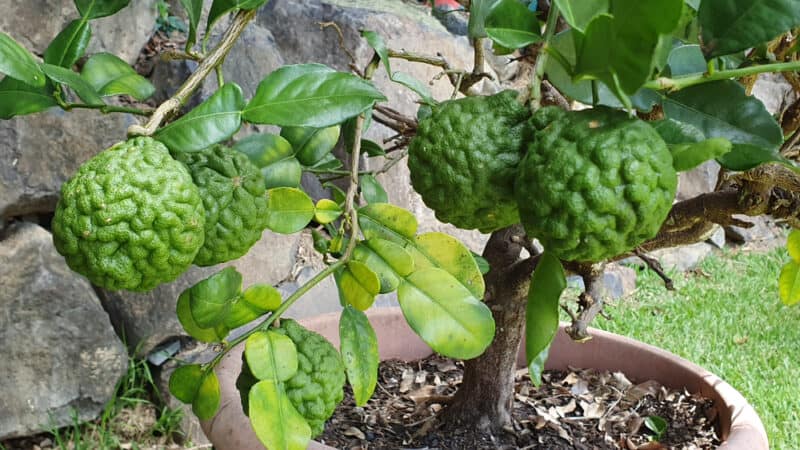

It’s essential to notice right here that though it’s possible you’ll be fascinated with rising citrus bushes indoors, that doesn’t imply that they’re going to give you scrumptious, juicy fruit.
Loads of situations have to be met to ensure that citrus bushes to flower and fruit, and if these aren’t met, then you definately’ll have beautiful ornamental bushes with fantastically aromatic leaves, however a dearth of fruits to get pleasure from.
Your greatest wager for a fruiting tree is to buy a younger one from a backyard middle that’s a minimum of two to 3 years outdated. These might begin to bear fruit from the three-year mark onwards however might take even longer. Many citrus bushes gained’t flower or fruit till they’re seven to 10 years outdated!
Preserve this in thoughts when planning your citrus bushes indoors. If you happen to’re okay with having no expectations of your bushes, then you’ll be able to get pleasure from them whether or not they find yourself fruiting or not.
If you happen to’re keen for his or her fruits, nonetheless, be certain that you analysis their care completely earlier than buying them or rising them from seed. This fashion, you’ll be able to attempt to supply them the most effective rising surroundings doable to allow them to develop massive and powerful sufficient to give you luscious, zesty fruits.
Yes No
×
Your reply can be used to enhance our content material. The extra suggestions you give us, the higher our pages might be.
Facebook Pinterest
Citrus bushes might be absolute treasures to develop at house. Along with their scrumptious fruits, their blossoms and leaves are sublimely aromatic, and lots of citrus components have medicinal and cleaning properties.
However what in the event you don’t dwell in USDA Zones 8-11 and might’t develop lemons, limes, or oranges open air? If you happen to’re feeling adventurous, you’ll be able to strive rising citrus bushes indoors as a substitute.
Can You Develop Citrus Bushes Indoors?


The easy reply right here is “sure.” Individuals have cultivated citrus bushes indoors of their properties or greenhouses for hundreds of years. The truth is, the traditional Romans grew citrus bushes in proto-greenhouses often called “solaria.”
They used thinly sliced selenite gypsum in lieu of glass for his or her solaria, the place they grew melons, citrus, and different summer time fruits year-round.
Like most different fruit bushes, rising citrus bushes indoors works effectively, offered they get sufficient mild and persistently heat temperatures. The bottom line is to get an acceptable species that’ll thrive in your house surroundings after which nurture it lovingly because it matures.
Gentle and Temperature Wants


One of many major causes citrus bushes thrive in areas nearer to the equator is the sheer quantity of warmth and sunshine they get day by day.
To develop citrus bushes indoors, you want a superb 8-12 hours of daylight day by day, and constant temperatures that don’t drop beneath 65-70°F (18-22°C) with few exceptions.
As such, you’ll have to develop your bushes close to the sunniest window you might have and/or present develop lights for supplemental UV publicity.
A south-facing window is good as a result of it’ll grant your bushes probably the most mild and heat doable. That mentioned, in the event you’re in a chilly local weather, you’ll want to make sure that no drafts are coming in by way of the window.
Citrus bushes indoors and out are very delicate to temperature fluctuations, so in the event you’re in Zones 3-6 and also you don’t have double-glazed home windows, take into account sealing them with plastic over the winter so your bushes don’t catch chilly.
Through the summer time months, you’ll be able to take into account transferring your citrus bushes exterior to allow them to get full publicity to sunshine, rain, and native pollinators. Simply notice that you simply’re additionally exposing them to potential pathogens and bug infestations by doing so. Extra on that later.
These bushes are additionally delicate to humidity ranges and don’t fare effectively in terribly dry environments. If you happen to discover that your private home is sort of dry in the course of the winter months (particularly widespread in the event you burn wooden for warmth), then it’s a good suggestion to spend money on a humidifier.
Moreover, use a twig mister in your bushes repeatedly to allow them to soak up moisture by way of their leaves.
Soil and Water


In the case of the soil, you’ll want on your citrus bushes, drainage is your greatest good friend. Severely, it’s good to make drainage a precedence, otherwise you’ll danger root rot and fungus gnats.
Select massive containers on your bushes and fill them with well-draining potting soil. This could include loads of perlite or volanic rock for each aeration and drainage, in addition to coconut coir and/or peat moss to retain moisture.
Citrus bushes favor impartial to barely acidic soil, so search for one within the 6.0 to 7.5 pH degree. Industrial soils that additionally include worm castings or aged compost may help hold your bushes well-nourished as effectively.
One thing like FoxFarm’s Ocean Forest potting combine could be good. Seize some from Amazon in 12-quart baggage.
Intention to fertilize your indoor bushes each 4-6 weeks all through the rising season, in any other case they’ll deplete vitamins from their soil fairly shortly. They do effectively with a balanced N-P-Ok ratio fertilizer or with common doses of selfmade compost tea.
By no means use fertilizer sticks, as they will “burn” the roots.
You’ll find fertilizers made particularly for potted citrus bushes, like Bloom Metropolis’s Natural Citrus & Fruit Fertilizer, obtainable at Amazon.
So far as watering goes, youthful bushes (below the age of 4 or so) have to be watered as soon as every week in the course of the rising season, whereas extra mature bushes can go so long as 10-14 days between waterings.
You don’t wish to water them too typically or else you danger root rot. Ideally, in the event you stick your finger down into the soil to the second knuckle, you need to simply have the ability to really feel moist soil. It shouldn’t be moist sufficient to stay to you while you pull it again out once more.
Think about using a soil moisture meter to maintain issues regulated, as both an excessive amount of or too little water can kill your tree(s).
Your citrus bushes don’t have to be watered as typically in the course of the winter months. They go dormant and gained’t soak up a lot of the water you supply them.
By no means hydrate your citrus bushes with chilly water. This may make them “shiver” and drop their leaves from shock. The water you employ ought to at all times be at room temperature or perhaps a little bit hotter so that you don’t traumatize your bushes.
Care and Upkeep


If you happen to don’t need your citrus bushes to develop up by way of your ceiling, you’ll seemingly have to prune them. Kumquats are sufficiently small so that you don’t have to fret about this problem, however for all of the others, you’ll have to trim them again repeatedly.
It’s greatest to prune citrus bushes throughout their early rising season, sometimes in spring or early summer time, or after they’ve fruited. Use sterilized backyard snips to chop again the branches and to trim them in the course of the rising season if issues begin to bush out an excessive amount of.
Moreover, it’s essential to notice that many citrus bushes have spiky thorns on their branches. These develop to guard the bushes from predators and might be lower than pleasant if and while you again into them whereas vacuuming.
They can be fairly harmful when you’ve got young children or rambunctious pets round. It’s a good suggestion to make use of these sterile snips to chop off the thorns so no one will get harm.
As an apart, bear in mind which you could at all times espalier your citrus tree indoors if you wish to save house. This requires you to coach their branches horizontally towards a sunny wall, reasonably than permitting them to bush out. It’s a terrific possibility for smaller areas, offered they get sufficient sunshine every day.
Potential Points


If you happen to’re cultivating these bushes for fruit, it’s essential to notice that though most citrus bushes are self-fertile, lots of them are wind-pollinated within the wild.
As such, it’s possible you’ll have to placed on some candy tunes and pollinate your citrus flowers with a smooth paintbrush to get the pollen from anthers to types.
Moreover, though citrus bushes indoors are much less prone to be affected by the identical well being points that out of doors bushes might undergo, there are a number of issues that they will nonetheless undergo from:
On the off likelihood that your different houseplants get contaminated with spider mites, these can mosey on over to your citrus bushes as effectively.
Earlier on this article, we mentioned how one can transfer your bushes exterior in summertime to allow them to play within the sunshine and rain for some time. This makes them very comfortable but in addition makes them a goal for predators and pathogens.
It’s as much as you whether or not you’d prefer to danger them getting rust, canker, or different ailments from being uncovered to the weather.
Moreover, citrus bushes want adequate nitrogen or they’ll begin dropping their leaves. In case your tree’s leaves are trying yellow or drooping and falling off, give them a dose of high-nitrogen fertilizer. That is particularly essential throughout their foliar section in spring and early summer time earlier than they flower in earnest.
The Greatest Citrus Bushes for Indoor Areas
Until your private home has severely tall ceilings, you’ll both wish to look into dwarf cultivars or hold your pruning shears helpful. Commonplace citrus bushes can develop between ten and 22 ft in top, whereas dwarf varieties common between six and 11 ft.
1. Clementine


These fairly citrus bushes (Citrus × clementina) produce among the tastiest fruits round, and are unlikely to develop taller than 8 ft when grown in a pot indoors.
Because the common ceiling in North America is 8-10′, you may get away with rising clementines in nearly any room in your home, offered that it will get sufficient daylight. If you happen to discover that it’s getting too tall, with leaves brushing the ceiling, prune it again to round 7 ft.
2. Cara-Cara


If you happen to love berries as a lot as you like citrus, then take into account rising a cara-cara (C. × sinensis ‘Cara Cara’). These citrus bushes produce fruits that style like a mixture of orange, pink grapefruit, raspberry, and cranberry.
Severely, in the event you haven’t tried them earlier than, see if you may get your palms on a few of these fruits at your native South American grocery retailer. They’re initially from Venezuela however have naturalized in tropical areas.
3. Trovita Orange
Not solely are the blossoms from Trovita orange (C. × sinensis ‘Trovita’) bushes scented exquisitely, however in addition they produce among the sweetest orange fruits round.
They’re exceptionally low-maintenance and gained’t develop too massive in the event that they’re planted in smaller containers, round 9 ft at full maturity. Though these citrus bushes want much less warmth than different cultivars, their fruit can be sweeter and juicier if their environment are fairly scorching.
4. Tangerine


In contrast to the opposite citrus bushes on this checklist, tangerines (C. x tangerina) are solely partially self-fertile. As such, though they may produce fruit in the event you pollinate them from their very own blossoms, you’ll get a extra considerable harvest in the event you develop a minimum of two bushes for cross-pollination.
Dancy tangerines, particularly, are treasured by indoor growers as a result of they solely develop about 9 ft tall in pots and are way more drought-tolerant than different cultivars.
5. Kumquat


Kumquat citrus bushes (Citrus spp.) are among the loveliest crops you’ll ever see. Severely, they’re ridiculously cute, aromatic, and produce super-tasty fruits as effectively. You can’t go mistaken with having a minimum of certainly one of these at house.
Dwarf varieties solely develop about six ft tall, and produce quail egg-sized fruits which are completely scrumptious. You’ll be able to stunt their progress by maintaining them in smaller containers, and a few individuals even domesticate their kumquats as bonsai bushes!
If you happen to go this route, you’ll be able to plop yours onto any sunny countertop in your house and develop your citrus bushes indoors proper the place you’ll be able to get pleasure from them.
Decide up a three- to five-inch dwell plant at Amazon.
6. Limequat


If you happen to guessed that it is a hybrid between a kumquat and a lime, you’d be appropriate. Nicely executed! Limequats (C. × floridana) are normally hybrids between key limes and kumquats, and the fruits have sweet-tart flesh and skinny, edible skins.
I favor to not eat the skins, however they’re fantastic in selfmade marmalade. These bushes are between six and ten ft tall at full maturity, so that they’ll match into most house environments with a little bit of mild pruning.
7. Lemon


When life provides you lemons… develop extra lemon bushes from them!
No, severely: I’ve two lemon bushes (C. × limon) that I’ve grown from seed (harvested from an natural, store-bought lemon), and I completely love them.
They’re over 12 ft tall now, and though they’re nonetheless too younger to bear fruit, the perfume from the leaves is past beautiful. A typical potted lemon tree will develop 10-15 ft tall at maturity, so except you might have ridiculously excessive ceilings, you’ll must prune yours down.
Right here’s a tip: lengthy earlier than your lemony citrus bushes bear fruit, you should utilize the leaves various alternative ways. Crush them barely in your palms and tuck them between sheets in your linen closet to impart a beautiful scent.
Dry them and crumble them into sachets to deodorize footwear and boots, or infuse vinegar and water with them for an eco-friendly room spray deodorizer.
Wager you didn’t know that rising citrus bushes indoors would allow you to clear your home!
8. Dwarf Meyer Lemon


Meyer lemons (C. x meyeri) are a few of my favourite citrus fruits. They’re sweeter and fewer acidic than customary lemons, and their blossoms fill the air round them with an unimaginable perfume.
You should buy dwarf Meyer lemon citrus bushes at nurseries — both native or on-line — or just purchase some natural Meyer fruits and sprout the seeds your self in the event you don’t thoughts ready a number of additional years on your bushes to bear fruit.
If you happen to’re in Florida, seize a dwell Meyer lemon plant in gallon pots at Amazon. Exterior of Florida, yow will discover a six- to- ten-inch dwell plant at Amazon.
9. Lime


If you happen to actually like the flavour of lime, then you’ll be able to’t go mistaken with a luscious lime tree rising in your kitchen or front room. Their flowers and leaves odor unimaginable, and their fruits are attractive in varied worldwide dishes, in addition to in refreshing drinks and tonics.
A median lime tree will develop as much as ten ft when mature however will seemingly be shorter than when grown indoors in a pot.
Moreover, limes (Citrus spp.) might be invaluable across the homestead for medicinal and cleansing functions. Lime has important antimicrobial properties, and the extract (tincture) and important oil (EO) can be utilized to deal with contaminated wounds.
Moreover, lime EO is superb for disinfecting surfaces like kitchen and toilet counter tops, because it’s an efficient antibacterial and antifungal as effectively.
‘Bearss’ is a superb lime for indoors as a result of it stays small. It’s additionally extraordinarily tolerant of low temperatures, even just under freezing.
Kaffir limes can be good, although you’ll have to prune them repeatedly as they will develop massive. If you happen to’d like a kaffir lime for rising indoors, head to Amazon for a 3 to five-inch tall dwell plant.
10. Finger Lime


Australian finger lime bushes (C. australasica) are perfect for smaller areas, as they solely develop six to eight ft tall at full maturity. Their fruits can develop three to 5 inches lengthy, with granular, pearl-like flesh that tastes (and feels) reasonably like lime-flavored caviar.
These are completely ideally suited citrus bushes to develop indoors, as they’re simply as low upkeep as they’re stunning. And scrumptious.
A Few Issues to Bear in mind


It’s essential to notice right here that though it’s possible you’ll be fascinated with rising citrus bushes indoors, that doesn’t imply that they’re going to give you scrumptious, juicy fruit.
Loads of situations have to be met to ensure that citrus bushes to flower and fruit, and if these aren’t met, then you definately’ll have beautiful ornamental bushes with fantastically aromatic leaves, however a dearth of fruits to get pleasure from.
Your greatest wager for a fruiting tree is to buy a younger one from a backyard middle that’s a minimum of two to 3 years outdated. These might begin to bear fruit from the three-year mark onwards however might take even longer. Many citrus bushes gained’t flower or fruit till they’re seven to 10 years outdated!
Preserve this in thoughts when planning your citrus bushes indoors. If you happen to’re okay with having no expectations of your bushes, then you’ll be able to get pleasure from them whether or not they find yourself fruiting or not.
If you happen to’re keen for his or her fruits, nonetheless, be certain that you analysis their care completely earlier than buying them or rising them from seed. This fashion, you’ll be able to attempt to supply them the most effective rising surroundings doable to allow them to develop massive and powerful sufficient to give you luscious, zesty fruits.
Was this text useful?
Yes No
×
We respect your useful suggestions!
Your reply can be used to enhance our content material. The extra suggestions you give us, the higher our pages might be.
Comply with us on social media:
Facebook Pinterest
